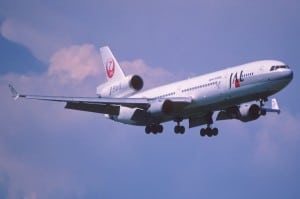Latest News
[Via Satellite 07-09-2014] In-flight connectivity (IFC) has become a top market opportunity for the satellite industry but despite this Euroconsult believes it will not be a profitable market until 2023. Though still nascent, this year alone has seen fast-paced developments as airlines scramble to outfit their planes and as satellite companies pivot to provide the tools to meet those needs. But high early investment costs have prevented passenger connectivity services — the bread and butter of IFC — from generating enough revenue to be considered profitable, according to Euroconsult Senior Consultant Wei Li. This critical inflexion point is still a number of years away.
“Revenue from passenger connectivity is expected to grow with an 18 percent CAGR (Calculated Annual Growth Rate) over the 2013 to 2023 period,” Li told Via Satellite. “By 2023 we expect the service will become profitable. However, we do not expect the whole in-flight connectivity provider community will reach break-even in the next three years, as most of them are still investing in the infrastructures.”
Euroconsult’s newly released report, Prospects for In-Flight Entertainment and Connectivity, anticipates the number of commercial aircraft providing IFC for passengers to reach 12,900, and the number of business aircraft to reach 24,000 over the next 10 years. At present, 59 airlines provide IFC through satellite or Air-to-Ground (ATG) networks. The surging number of connected aircraft is expected to boost revenues from $440 million in 2013 to $2.1 billion in 2023, at which point Euroconsult anticipates IFC will turn a profit.
Looking at the Average Revenue Per User (ARPU), Li said it is important to measure by two different scales: average revenue per passenger and average revenue per plane. While both are expected to increase, revenue per plane will outpace revenue per passenger. Currently, only 6 percent of passengers are willing to pay for connectivity. Gauging revenue by plane includes connectivity for flight operations and cockpit applications, which are expected to further drive uptake. But Li added that passenger connectivity will ultimately remain dominant.
“We can compare the aero market with the maritime market,” he said. “All deep sea vessels have the Inmarsat safety communications which represent an impressively large installation base. The number of maritime VSATs (Very Small Aperture Terminals) is tiny when compared to it, but one VSAT can generate as much as 10 times more revenue than a safety communications terminal. In many cases, up to 80 percent of the VSAT capacity is used for crew entertainments … flight operation and cockpit will bring revenue opportunities, [but] the pillar will still be passenger connectivity.”
As IFC evolves, the satellite industry has responded positively by angling to capitalize on ever-increasing demand. New satellites are increasingly focused on capturing market share, as evidenced by Panasonic Avionics’ anchor client position on Eutelsat 172B and Inmarsat’s shared satellite Europasat/Hellas-Sat 3. Li described the situation for FSS operators seeking to presell capacity as a “perfect fit.”
“When you look at the satellite capacity used for in-flight connectivity today, most of the capacity is leftover from satellites designed for DTH TV broadcasting service or maritime services. This has been changing over the past 24 months. Connectivity providers now have the financial resources to allow them to commit to large amounts of capacity before the satellites are launched. They expect the coverage and capacity to be tailored to their requirements and they are willing to pay for it,” said Li.
Euroconsult expects competition among ATG networks to increase as well. This is already proving true around the globe. While Gogo once stood as the only ATG operator, satellite operator Inmarsat and telcos AT&T and China Mobile have announced ATG plans in Europe, North America and China respectively. These ATG networks are expected to boost regional connectivity and further influence hybrid satellite-terrestrial networks.
As IFC evolves, so too will the satellite landscape. Notably, operators with global coverage stand to benefit the most, said Li.
“The market will become more challenging for small regional satellite operators; as larger operators can tailor global coverage for connectivity providers, IFC providers no longer need to seek for pieces of regional beams and make the combination themselves for their own global coverage.”
But this does not mean IFC is a lost cause for smaller players. Partnerships and new business models can spur on opportunities. As airlines around the world seek to connect their aircraft, Euroconsult expects regional providers to proliferate.
“We do expect more regional IFC players to enter the market,” said Li. “The competition will become stronger. On the other side, the entry barrier into the aeronautical market has historically been high. These new investments will very possibly need partnerships with established players. In addition, M&As will also be possible in the future for both new projects and established players.”
Get the latest Via Satellite news!
Subscribe Now